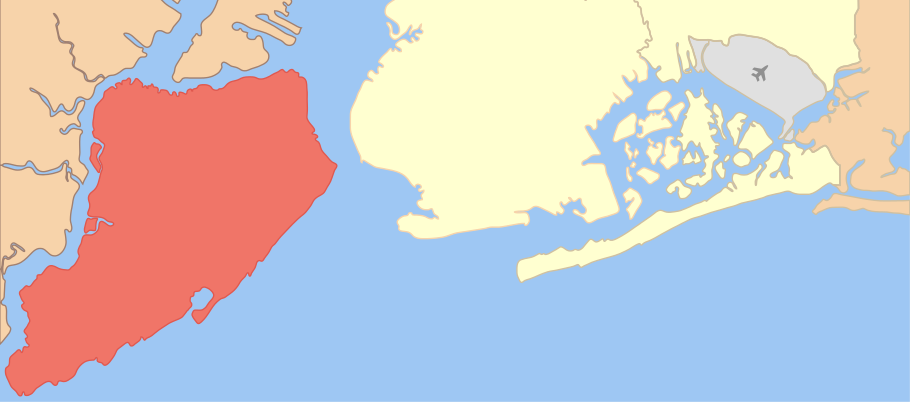Summary: Staten Island is confronting urban deer overabundance with a plan to sterilize all of its male deer. Animal rights groups praise the plan as forward looking and humane, but it is neither. It will be difficult to implement, wildly expensive, and it will alter the reproductive behavior of male and female deer, leading to an increase in vehicular collisions and physiological stress. A deer cull — possible even in Staten Island — would give the remaining deer a more natural life and improve deer-human interactions.
Narrow channels isolate Staten Island (red) from New Jersey (orange) and New York City (yellow). https://commons.wikimedia.org/w/index.php?curid=10668334
In Ann Arbor deer management has been a hot news item for nearly a year. When it comes to non-lethal methods, someone occasionally brings up the possibility of buck sterilization (i.e. vasectomy). The idea is rejected fairly quickly. Unlike the more sedentary female deer (does) bucks travel broadly and they are polygamous; i.e. they will mate as often and with as many females as they can. If you manage to sterilize one buck, another will come to take its place.
A few of us were therefore amused to see that NYC Mayor Bill de Blasio had proposed a $2 million (year 1) plan to sterilize bucks on Staten Island. The goal is to sterilize all of the male deer (about 40% of the herd, an estimated 400 bucks) over a several year period. This amounts to about $5,000 per buck if they sterilize all of them in the first year.
This seems like an obscene amount of money to spend on a relatively small deer herd. In Ann Arbor, the City established a contract with the USDA to cull 100 deer for $35,000 ($350 per deer). This past winter USDA marksmen shot 63 deer, and the venison was distributed to needy families. Compared to Staten Island, this was a bargain. The USDA coordinated with local police to clear parks prior to the cull, so it was also safe while done within City limits.
It might be more difficult to allow USDA marksmen into Staten Island. Firearms are not essential for lethal deer control, however. For example, it is possible to dart and euthanize deer, or use clover traps.
Because Staten Island is an island, it may be possible to sterilize every single male deer and not have to worry about many immigrant bucks. Reaching the goal of complete male sterilization will, however, be an enormous challenge. While technicians are busy shooting bucks with tranquilizer darts during the fall mating season, the unsterilized bucks will be actively inseminating does, giving rise to (potentially) hundreds of male fawns the following spring. Repeat the process in year two. This could take many years, and the deer population will have time to swell to even higher numbers than present.
Let’s assume that, after several years and several million dollars, all Staten Island bucks have been successfully neutered. What next?
Be prepared for some very odd deer behavior. The October-December mating season (rut) usually ends when the female deer become pregnant. When does do not become pregnant, they continue to cycle through estrus every 28 days through the winter. Does in heat are magnets for bucks. This causes physiological stress for both sexes.
Because deer are reproductively energized and moving erratically, the rut is the peak time for deer-vehicle collisions (DVCs). The uptick in DVCs will last for additional months. DVCs are traumatic and dangerous for the people involved (more traumatic than the thought of a cull), and they cause the deer to suffer substantially more than euthanasia. The higher rate of DVCs will cause the deer population to gradually decline, but at additional cost; the average vehicle damage cost from a DVC is ~$4,100.
Wayne Pacelle, CEO of the Humane Society of the United States (HSUS) praised the buck sterilization program as “forward thinking“. I have written about how HSUS misinformation about deer biology has contributed to political polarization in Ann Arbor and elsewhere.
I began writing this post after talking with the City Hall reporter for the Staten Island Advance (SILive.com). Since then, the reporter spoke with various deer experts, including Michigan Deer Specialist Chad Stewart and the Cornell University team. The resulting article was titled “Lunacy’: Experts slam city’s Staten Island deer vasectomy plan“.
Ann Arbor City Council has gone through a lot of political heat by supporting a deer cull. Their decision was based on solid information about deer impacts, public health risks and property damage, as well as testimony from deer biologists. It was forward thinking. Perhaps we can now develop a comprehensive deer management plan that other cities can emulate.
Disclaimer: These are my views and not official views of the University of Michigan.
